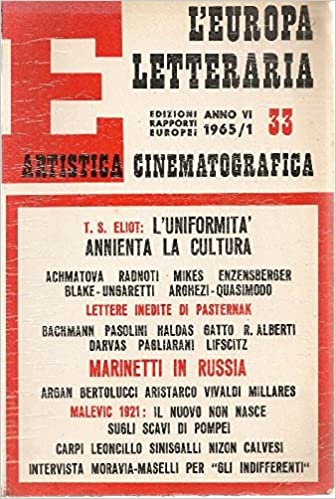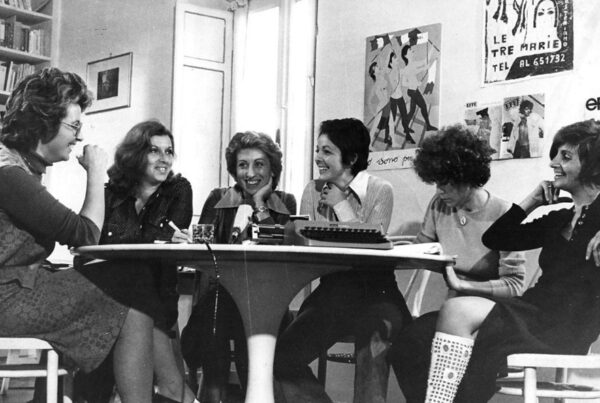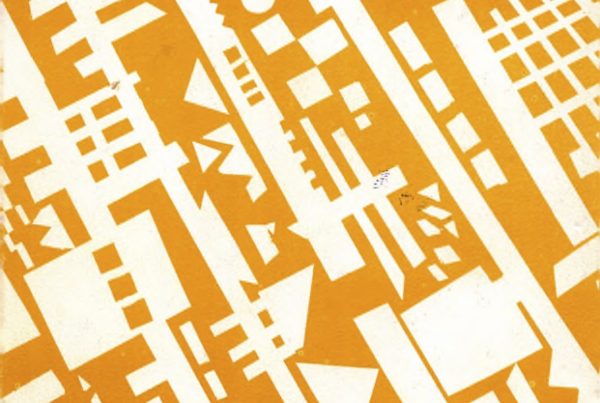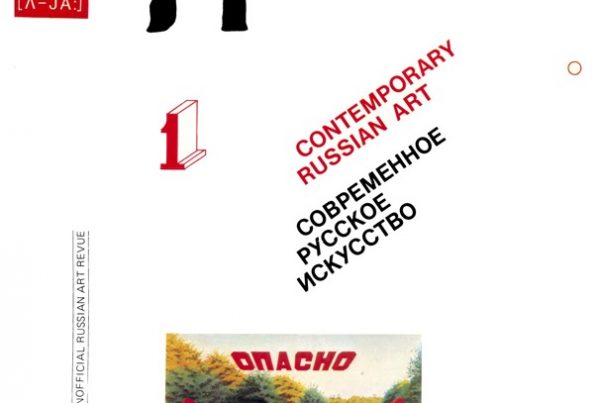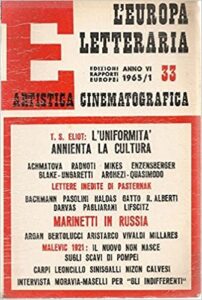
Cover: “L’Europa letteraria”, year VI, 1965/1, 33.
Title of the magazine:
“L’Europa letteraria” (Literary Europe)
Start date: 1st January 1960
End date: May-June 1965
Place of publication: Rome
Editorial committee: Giancarlo Vigorelli, Davide Lajolo, Domenico Javarone
Main Collaborators: Domenico Javarone, Davide Lajolo, Aleksandr Tvardovskii, Evgenii Evtushenko
Total number of issues: 26
Description:
“L’Europa letteraria” was founded on January 1st, 1960, in Rome by Giancarlo Vigorelli, who served as editor until 1965. During those five years, Vigorelli was joined first by co-director Domenico Javarone, and then by Davide Lajolo from issue 20/21 of April-June 1963.
The editorial and administrative offices were in Rome, initially located at 78, Via Micheli, moving in 1964 to 87, Via delle Muratte, and the following year to 11, Via Montanelli. The bimonthly journal published a total of 26 volumes with Edizioni Rapporti Europei (Editions with European Reports) from January 1960 to June 1965, when it ceased publishing.
From issue 3 of June 1960, the journal expanded to include the section L’Europa artistica (Artistic Europe) and from issue 9/10 of June/August 1961, the section L’Europa cinematografica (Cinematographic Europe) was added. Both these sections, which had their own cover pages and contained essays, articles, and reviews on artistic and cinematographic subjects, can be considered journals in their own right, so much so, that the last three issues of the magazine were published with the new title L’Europa letteraria, artistica e cinematografica (Literary, Artistic and Cinematographic Europe).
“L’Europa Letteraria” was originally divided into four parts: Testi (Texts), which included prose, poetry, and critical essays; Fatti e Idee (Facts and Ideas), which included articles on literature and art; Letture (Readings), with reviews of new literary releases; and Notiziario (News), which included the “Bulletin of the European Community of Writers” (COMES) but which was discontinued after a few issues. These sections were later joined by Testi e Galleria (Texts and Gallery) in L’Europa Artistica and Testi e Primi piani (Texts and Close-ups) in L’Europa Cinematografica.
The journal’s contents were essentially based on the same anti-fascist principles as COMES with an editorial line that was progressive and pan-European which aimed at encouraging interaction between Western and Eastern European cultures by creating a space for debate among intellectuals. The journal’s goal was to allow the “so-called two Europes to know and recognise one another” through the exchange of ideas (Vigorelli 1960: 8). According to Vigorelli, men of culture needed to stop “wasting time on monologues when dialogues are needed” (ibid: 11) to establish peaceful relations between the different European countries. In order to facilitate a rapprochement between peoples, the journal included writing by Italian intellectuals such as Ungaretti, Pasolini, Moravia, Riccio, Strada, and Luzi, as well as works in their original language or translation by intellectuals, writers, and artists from other European countries, such as Sartre, Hesse, Hemingway, Petrov and Evtushenko.
The editor also aimed to promote exchange between Marxism and the bourgeoisie, since he believed that “writers, artists […] and men of culture, because they are inherently inclined towards unity, are not afraid of division or disagreement, and do feel lost between opposing ideologies” (ibid.: 10). With these visions of unity in mind, the journal sought to bring together artists aligned with official Soviet culture, such as Kostantin Fedin or Aleksei Surkov with those on its fringes. One of the journal’s main contributors was Aleksander Tvardovskii, whose progressive Soviet journal, “Novii Mir”, greatly influenced the editorial direction of “L’Europa Letteraria”, which became the means through which the Italian public came to know the works of Anna Akhmatova, Boris Pasternak, Aleksandr Solzhenytsin, and Tvardovskii himself.
Vigorelli believed that continuous cultural confrontation was necessary to make “that ancient, and yet new, shared plant flourish” (ibid.) and to achieve a “unification and connection of men” (ibid.). The journal remained an extremely important channel for spreading and transmitting culture and for breaking down political and cultural barriers in Europe at a time when the channels of communication were extremely fragile.
As the years went by, however, Vigorelli’s vision became increasingly problematic. The journal began to lose its influence with the advent of mass media, a phenomenon which was highlighted by Vigorelli in the last issues of the journal which, he said, was attempting to continue to wage its “war of ideas, a war whose weapon is criticism and whose victory is freedom” (Vigorelli 1965: 186). The editor’s battle cry was in vain and “L’Europa Letteraria” was forced to close with issue 35 of May-June 1965.
Notes: The issues consulted in this study from “L’Europa letteraria” (1960-1965) were found in the Central National Library of Florence. It was not possible to find issues 25, 28, or 29, nor was it possible to consult the index of issue 26.
Claudia Borrelli
[30th June 2021]
Translation by Claudia Borrelli
Bibliography
- Comes. Tavola Rotonda a Belgrado, “L’Europa Letteraria”, VI.35 (maggio-giugno 1965): 179-215.
- D’Ambrosi C., La civiltà letteraria negli anni ’60-’65 in URSS attraverso le riviste “Tempo presente” e “L’Europa letteraria”, Master Thesis, Università degli Studi di Firenze 2016/2017.
- Gaddo P. (ed.), L’Europa Letteraria, https://r.unitn.it/it/lett/circe/leuropa-letteraria, online (last accessed: 30/06/2021).
- Reccia A., L’Italia nelle relazioni culturali sovietiche, tra pratiche d’apparato e politiche del disgelo, “e-samizdat”, 2012-2013, IX, http://www.esamizdat.it/ojs/index.php/eS/issue/view/4, online (last accessed: 30/06/2021).
- Sabbatini M., Dicembre 1964: Anna Achmatova in Italia. Un caso di diplomazia culturale italo-sovietica, “e-samizdat”, 2012-2013, IX, http://www.esamizdat.it/ojs/index.php/eS/issue/view/4, online (last accessed: 30/06/2021).
- Sabbatini M., Lagernaia proza Solzhenitsyna v zerkale ital’ianskoi kritiki, “Tekst i traditsiia. Al’manakh”, 6, Rostok, Sankt-Peterburg 2018: 72-76.
- Vigorelli G., L’Europa, questo rapporto, “L’Europa Letteraria”, I.1 (January 1960): 8-11.
- Vigorelli G., Le Riviste letterarie europee nell’attuale situazione culturale ed editoriale, “L’Europa Letteraria”, VI.35 (maggio-giugno 1965): 186.
- Vigorelli G., Diario europeo. Occasioni e testimonianze critiche sulla letteratura europea 1950/1975, SEI, Torino 1977
- Vigorelli G., Diario moscovita. Appunti sul despotismo Russo, G. Giovannelli (ed.), Mimesis edizioni, Sesto San Giovanni (MI) 2014.
To cite this article:
Claudia Borrelli, L’Europa letteraria, in Voci libere in URSS. Letteratura, pensiero, arti indipendenti in Unione Sovietica e gli echi in Occidente (1953-1991), a cura di C. Pieralli, M. Sabbatini, Firenze University Press, Firenze 2021-, <vocilibereurss.fupress.net>.
eISBN 978-88-5518-463-2
© 2021 Author(s)
Content license: CC BY 4.0
